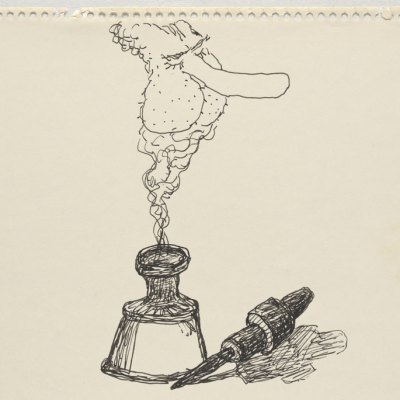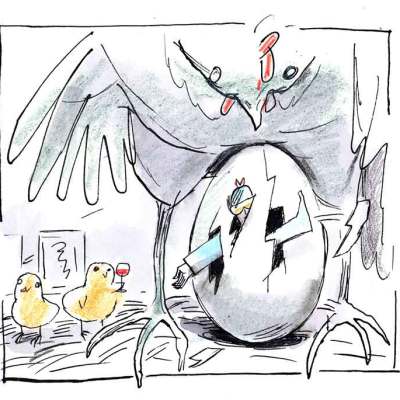Almost 40 years after his death, we are still measuring the achievement of Philip Guston. Just a few weeks ago, while giving a talk about The Studio (1969), I was dumbstruck by a crappy projection of The Line (1978), a work he painted two years before he died. Both works feature among the dozens of paintings and drawings that will be shown in a major exhibition, ‘Philip Guston and the Poets’, at the Gallerie dell’Accademia in Venice this summer (10 May–3 September). Looking at my hazy, blown-up facsimile of The Line, which depicts a raw, red hand descending from the sky to scrape a line across the ground, I froze. I know this painting well – and have seen the canvas itself a few times – and yet I paused, seeing something new. I’m reluctant to admit it, but I was almost moved to tears. What was it that astonished me?
The Line (1978), Philip Guston. Courtesy Hauser & Wirth; © The Estate of Philip Guston

It’s not a complex image. A gigantic, time-ravaged hand emerges from a pillowy bank of cartoonish clouds. This is no idealised limb dropping from the heavens to bless us foolish mortals, nor to reveal a timeless truth: God’s wrist and hand are fleshy and flayed, on the edge of decay – revelation as a haemorrhoidal ooze. But in this late masterpiece, Guston condenses so much thought and experience: he offers a snippet of autobiography, slates a rival artist, and outlines the scope and ambition of 20th-century painting.
Flip the painting on its side and the line in the red earth resembles a Barnett Newman zip. On one level, then, here we have a joke about Newman’s lofty claims about his work, with Guston seeking to undermine its supposed sublimity: this is no vertical line of metaphysical ascension, but a ditch in the hardscrabble earth. The hand is also, inevitably, Guston’s own: in 1978 he was 65 – not especially old, but after a life of chain-smoking and heavy drinking, he probably knew that his lifeline was coming to its end. But the picture is also about writing, with its suggestion that both poet and painter share a hand that longs to emerge from the fog of the mind, making a mark and creating meaning in an empty space. So I must have been awestruck by the sheer number of ideas Guston packed into a painting that looks relatively artless, not to mention the balance of wit and melancholy that so energises the picture. A burst of laughter wouldn’t be out of place in front of The Line.
As much as Guston devoted himself to Rembrandt, Beckmann, Mondrian, Piero della Francesca, and to all the quattro- and cinquecento painting that he adored, literature was always a rival for his attention. ‘When someone asked me who I studied with,’ he once said, ‘I told them I studied with Dostoyevsky, Kierkegaard.’ Apart from fellow artists such as de Kooning, his closest friendships were with the poets Stanley Kunitz, William Corbett, Bill Berkson and Clark Coolidge, as well as his neighbour in upstate New York, Philip Roth. ‘Philip Guston and the Poets’ is the first exhibition to look at the strong influence writing and poetry had on the artist. It’s an insightful take on Guston’s work: it was his engagement with literature, I would argue, rather than the painters of his day, that cemented his spot in the history of 20th-century art.
It all started in 1968, when Guston started painting again, having taken a couple of years off after his survey at the Jewish Museum, New York, in 1966. One of the small paintings in the Venice show (Untitled, 1968) depicts a hand entering the square of the canvas from the left, its index finger extended to the edge of a red book marked by simple vertical strokes in black. The painting expresses a subtle longing. Guston famously said that he wanted to ‘tell stories’, but the phrase is easily misunderstood. When Guston says he wants to ‘tell stories’, he does not mean that his ambition is to make narrative paintings, or even – as he did – cartoon-like pictures of KKK thugs out on the town. Telling stories meant merely that he didn’t want to be a formalist. If the black slashes in the book have a minimalist touch, they could also be read as letters and words, their grid-like form a poem-painting.
The hand depicted in The Line, or one that strongly resembles it, appeared in a drawing a few years before he painted that late work. The Drawing (c. 1972) shows two fingers extended, a pen or brush poised awkwardly between them. It’s a modest hand, the poet’s or artist’s, and it is flanked by modest things: a radio, a lamp. The words, a poem by Clark Coolidge, and the lines in the drawing, have equal value. Quite apart from expressing his affinity with a poet, the drawing encapsulates Guston’s late-life revelation: every line, every mark, can be understood not strictly as a formal ingredient, but as a metaphor, and is therefore free to revel in instability, paradox, and contamination.
‘Philip Guston and the Poets’ is at the Gallerie dell’Accademia, Venice, from 10 May–3 September.
From the May issue of Apollo. Preview and subscribe here.


